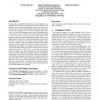Free Online Productivity Tools
i2Speak
i2Symbol
i2OCR
iTex2Img
iWeb2Print
iWeb2Shot
i2Type
iPdf2Split
iPdf2Merge
i2Bopomofo
i2Arabic
i2Style
i2Image
i2PDF
iLatex2Rtf
Sci2ools
SIGMOD
2008
ACM
2008
ACM
Scalable network distance browsing in spatial databases
An algorithm is presented for finding the k nearest neighbors in a spatial network in a best-first manner using network distance. The algorithm is based on precomputing the shortest paths between all possible vertices in the network and then making use of an encoding that takes advantage of the fact that the shortest paths from vertex u to all of the remaining vertices can be decomposed into subsets based on the first edges on the shortest paths to them from u. Thus, in the worst case, the amount of work depends on the number of objects that are examined and the number of links on the shortest paths to them from q, rather than depending on the number of vertices in the network. The amount of storage required to keep track of the subsets is reduced by taking advantage of their spatial coherence which is captured by the aid of a shortest path quadtree. In particular, experiments on a number of large road networks as well as a theoretical analysis have shown that the storage has been
| Added | 15 Dec 2010 |
| Updated | 15 Dec 2010 |
| Type | Journal |
| Year | 2008 |
| Where | SIGMOD |
| Authors | Hanan Samet, Jagan Sankaranarayanan, Houman Alborzi |
Comments (0)

